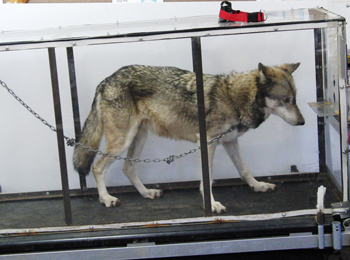
Photo by Monty Sloan
Consider yourself fortunate if you spot a gray wolf (Canis lupus) during your visit to Denali National Park and Preserve. Consider yourself even luckier if the wolf is wearing a collar. Several wolves in Denali are collared as part of an exciting new study investigating the behaviors of wolves as they hunt, raise pups, and patrol territories in the wild expanses of interior Alaska.
Predator Movements Matter
Wolves in Denali are a keystone species. This means their presence is crucial in maintaining the collection of other animals and plants around them. Studying wolves is clearly important to understanding how an ecosystem functions, but their far-ranging movements in rugged, often remote habitat make this a daunting task. For decades, scientists have used radio (and more recently, GPS) tracking collars to follow the movements of wolves and other animals that are difficult to observe in the wild. While scientists have learned a great deal about how far-reaching wolf ranges are and where they reside during each season, they still know little about the actual behaviors wolves are engaged in and the cost of those actions. By discovering more infomation about the secret lives of wolves, managers and conservationalist will be able to make better informed decisions in the future.

Photo by Caleb M. Bryce
SMART collars link behavior, physiology, and ecology
So, how exactly can a collar measure metabolic costs of wolf activities in the wilds of Denali? The answer is surprisingly anything but wild. These SMART collars collect data using the same sensor technology that is in smart phones, wearable fitness devices, and gaming platforms. The widespread adoption of mobile electronics has fueled the recent development of a multitude of inexpensive miniature sensors such as accelerometers, magnetometers, global positioning systems (GPS), and cameras. This technology is now being repurposed into tags and wildlife collars and made available to wildlife ecologists and resource managers to remotely monitor movement patterns and activities of wolves and other wild animals.
One design, the SMART (Species Movement, Acceleration, and Radio Tracking) collar, was developed by scientists and engineers at the University of California, Santa Cruz. The collar simultaneously measures the geographic location, behavior, and physiology of the animal wearing it. Because the three-dimensional movement associated with each behavior is unique, accelerometers in the collar create distinct “data signatures” for wolf activities such as sleeping, eating, walking, and running. Each of these behaviors has an associated energetic cost (e.g., more calories are burned while running than sleeping), so the metabolic rate of a wolf performing each of these activities can be measured to create an energy budget for the animal.
How do you count the number of calories spent in different activities for a wolf? Researchers train captive wolves wearing the SMART collar to rest, eat, and move at varying speeds on a treadmill while enclosed in a metabolic chamber (i.e., large Plexiglas box) enclosing the apparatus. An O2 analyzer then measures the faint depletion of oxygen in the chamber from breathing over time. The rate of oxygen consumption is then converted into the wolf’s metabolic rate, which is then expressed as calories per minute required for a given behavior. Behavior signatures from the collar’s accelerometer are then matched to these activity-specific energetic costs, thus enabling scientists to decipher both behavior and metabolic demand from collared wild wolves.

Photo by Caleb M. Bryce
Revealing the Secret Lives of Denali's Wolves
In 2015, researchers from UC Santa Cruz and Denali’s National Park Service (NPS) collaborated to explore this new frontier in wildlife tracking technology. SMART collars were placed on wolves in packs throughout Denali to continuously record each collared animal’s location, behaviors, and metabolic rate. Wolf packs in regions of the park with known differences in topography and prey availability were selected to investigate the role of these variables. The collars remained on the wolves for over seven months and recorded data that will paint a detailed picture of not only where wolves were on the landscape, but what they were doing on a moment-by-moment basis.
Over the course of the collar deployment, collaborators conducted camera trap and aerial surveys to observe these wolves, identify prey remains from kills, note the pack size, location of dens, the number of pups, and surrounding habitat attributes. These direct observations in combination with the detailed activity data gathered from the collars will aid in answering several unresolved questions. For example, what are the underlying environmental and physiological links to recent wolf starvation incidents in the Park? To what extent is prey selection and predation pressure by wolves driven by terrain differences and seasons?
Broader application
Despite their critical role in structuring ecosystems, the majority of large (>21 kg) mammalian carnivores are threatened with extinction. Many suffer from habitat fragmentation and loss. In an increasingly human-dominated world, the long-term survival of large land carnivores such as wolves depends on finding ways for people to coexist with them. Filling in current gaps in our understanding of these important carnivores in relatively intact ecosystems such as Denali can help inform conservation efforts elsewhere. By using novel technology and analytical approaches to tackle challenging but relevant research questions, scientists hope to understand how landscape attributes and changes in the environment affect the physiological demands of carnivores and so impact their survival, reproduction, ecological impacts, and conflict with humans.
First Findings
Initial findings suggest that wolves in western Denali have higher daily energy use than those to the east. This could have to do with western wolves having smaller pack sizes, home ranges that are larger, and living where the densities of ungulate prey (moose, caribou, and Dall sheep) is lower. From here, the team will collect additional data from captive wolves to further understand the patterns observed in wolves in Denali.
Last updated: March 21, 2017
